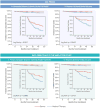Device Closure of Patent Foramen Ovale After Stroke: Pooled Analysis of Completed Randomized Trials
- PMID: 26916479
- PMCID: PMC4769377
- DOI: 10.1016/j.jacc.2015.12.023
Device Closure of Patent Foramen Ovale After Stroke: Pooled Analysis of Completed Randomized Trials
Abstract
Background: The comparative effectiveness of percutaneous closure of patent foramen ovale (PFO) plus medical therapy versus medical therapy alone for cryptogenic stroke is uncertain.
Objectives: The authors performed the first pooled analysis of individual participant data from completed randomized trials comparing PFO closure versus medical therapy in patients with cryptogenic stroke.
Methods: The analysis included data on 2 devices (STARFlex [umbrella occluder] [NMT Medical, Inc., Boston, Massachusetts] and Amplatzer PFO Occluder [disc occluder] [AGA Medical/St. Jude Medical, St. Paul, Minnesota]) evaluated in 3 trials. The primary composite outcome was stroke, transient ischemic attack, or death; the secondary outcome was stroke. We used log-rank tests and unadjusted and covariate-adjusted Cox regression models to compare device closure versus medical therapy.
Results: Among 2,303 patients, closure was not significantly associated with the primary composite outcome. The difference became significant after covariate adjustment (hazard ratio [HR]: 0.68; p = 0.049). For the outcome of stroke, all comparisons were statistically significant, with unadjusted and adjusted HRs of 0.58 (p = 0.043) and 0.58 (p = 0.044), respectively. In analyses limited to the 2 disc occluder device trials, the effect of closure was not significant for the composite outcome, but was for the stroke outcome (unadjusted HR: 0.39; p = 0.013). Subgroup analyses did not identify significant heterogeneity of treatment effects. Atrial fibrillation was more common among closure patients.
Conclusions: Among patients with PFO and cryptogenic stroke, closure reduced recurrent stroke and had a statistically significant effect on the composite of stroke, transient ischemic attack, and death in adjusted but not unadjusted analyses.
Keywords: cryptogenic stroke; meta-analysis; transient ischemic attack.
Copyright © 2016 American College of Cardiology Foundation. Published by Elsevier Inc. All rights reserved.
Figures


Comment in
-
PFO: "Please Figure Out," or Now "Potentially Figured Out?".J Am Coll Cardiol. 2016 Mar 1;67(8):918-920. doi: 10.1016/j.jacc.2015.12.022. J Am Coll Cardiol. 2016. PMID: 26916480 No abstract available.
References
-
- Khan AR, Bin Abdulhak AA, Sheikh MA, et al. Device closure of patent foramen ovale versus medical therapy in cryptogenic stroke: a systematic review and meta-analysis. JACC Cardiovasc Interv. 2013;6:1316–23. - PubMed
-
- Pineda AM, Nascimento FO, Yang SC, et al. A meta-analysis of transcatheter closure of patent foramen ovale versus medical therapy for prevention of recurrent thromboembolic events in patients with cryptogenic cerebrovascular events. Catheter Cardiovasc Interv. 2013;82:968–75. - PubMed
-
- Stortecky S, da Costa BR, Mattle HP, et al. Percutaneous closure of patent foramen ovale in patients with cryptogenic embolism: a network meta-analysis. Eur Heart J. 2015;36:120–8. - PubMed
Publication types
MeSH terms
Grants and funding
LinkOut - more resources
Full Text Sources
Other Literature Sources
Medical
Miscellaneous

